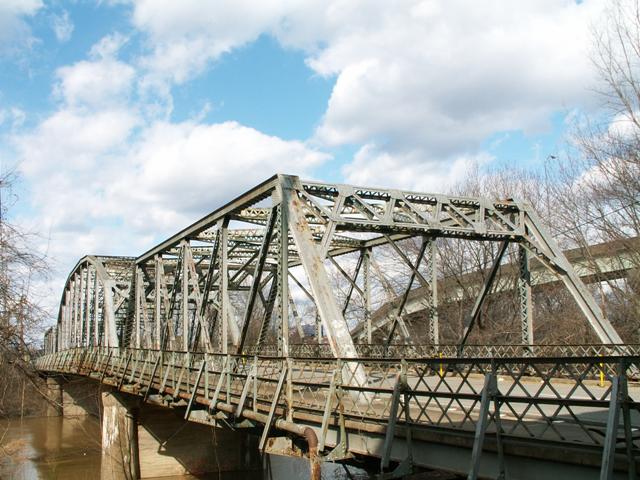We Recommend:
Bach Steel - Experts at historic truss bridge restoration.
5th Avenue Bridge

Primary Photographer(s): Nathan Holth and Rick McOmber
Bridge Documented: March 1, 2007
Not Available or Not Applicable
200.0 Feet (61 Meters)
485.0 Feet (147.8 Meters)
20.7 Feet (6.31 Meters)
3 Main Span(s) and 2 Approach Span(s)
6A011

View Information About HSR Ratings
Bridge Documentation
This bridge no longer exists!
View Archived National Bridge Inventory Report - Has Additional Details and Evaluation
This historic bridge was demolished June 18, 2010!
This impressive structure was a great example of 1920s truss bridge technology with remarkable historic integrity. It contained a pleasing variety of truss types arranged in a symmetric that is visually appealing. It consisted of a Pratt through truss span at each end, with a larger Parker truss rising up at the center to form the main span. Extensive lattice and v-lacing on the riveted structure combined to add to the aesthetic elements of the bridge. Original lattice railings of a unique design remained on the bridge.
Despite the value of this historic bridge and the potential for preservation, West Virginia chose to waste money and destroy history by demolishing this historic bridge, which due to lack of maintenance had fallen into disrepair but was not beyond saving in the view of HistoricBridges.org. When West Virginia announced demolition plans, some members of the public apparently recognized the value of the structure and alerted West Virginia to this. Rather than rehabilitate the structure however, West Virginia hired Modjeski and Masters to design replacement structures that supposedly would fill the shoes of this historic bridge. The different designs they came up with, one even a metal truss bridge, look nothing like the original bridge to anyone with half a sense of what the old bridge looked like. Such solutions also disregard the ideas that a structure is important because it is historic, and also that a historic structure means that the bridge is old. Any new bridge, even an exact replica, would not be historic, because it is not old. However, their truss bridge design is not even an exact replica, because it does not used rivets and uses plain-looking i-beams rather than intricate built-up beams with v-lacing, and is single span. Such mitigation alternatives, which often accompany historic bridge demolitions, should generally be considered a waste of money. Either the historic bridge should be preserved, or engineers should do what they do best these days, and design the plainest and simplest structure possible, and save the extra money for some other historic bridge rehabilitation project.
The only thing more disappointing than the demolition of the bridge was all the people that showed up to the site to witness the demolition. Quite a crowd of people gathered with cameras and video recorders. The reason this is disappointing is that so few people cared to photograph this historic bridge except when it was being blown up. A lot of this is because of the misinformation and stereotypes that are entrenched in the United States, particularly the absolutely false concept that the only type of historic bridge is a wooden covered bridge. People photograph covered bridges all the time. But the only most of the general public even notice metal truss bridges is when they are being imploded. This is why HistoricBridges.org endeavors to educate the public on the value of non-covered historic bridges, in the hopes that people will realize that there is a heritage worth appreciating in bridges such as the 5th Avenue Bridge.
![]()
Photo Galleries and Videos: 5th Avenue Bridge
Bridge Photo-Documentation
A collection of overview and detail photos. This photo gallery contains a combination of Original Size photos and Mobile Optimized photos in a touch-friendly popup viewer.Alternatively, Browse Without Using Viewer
![]()
Maps and Links: 5th Avenue Bridge
This historic bridge has been demolished. This map is shown for reference purposes only.
Coordinates (Latitude, Longitude):
Search For Additional Bridge Listings:
Bridgehunter.com: View listed bridges within 0.5 miles (0.8 kilometers) of this bridge.
Bridgehunter.com: View listed bridges within 10 miles (16 kilometers) of this bridge.
Additional Maps:
Google Streetview (If Available)
GeoHack (Additional Links and Coordinates)
Apple Maps (Via DuckDuckGo Search)
Apple Maps (Apple devices only)
Android: Open Location In Your Map or GPS App
Flickr Gallery (Find Nearby Photos)
Wikimedia Commons (Find Nearby Photos)
Directions Via Sygic For Android
Directions Via Sygic For iOS and Android Dolphin Browser
USGS National Map (United States Only)
Historical USGS Topo Maps (United States Only)
Historic Aerials (United States Only)
CalTopo Maps (United States Only)

